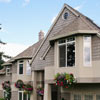Ventilation is Key to How Long Your Roof Will Last
More than ever, homeowners are frustrated by poor performing roofing products and upset when a new roof costing between $5,000 and $10,000 lasts only 12 to 15 years. In some cases, the problem is a troublesome brand of materials. More often, however, it is inadequate attic ventilation.
 Building standards, driven by energy shortages, have sewn up the homes that we live in tighter than a drum. Surprisingly, standards of ventilation adopted in the 1930s are still in use today! Most homes are woefully under ventilated.
Building standards, driven by energy shortages, have sewn up the homes that we live in tighter than a drum. Surprisingly, standards of ventilation adopted in the 1930s are still in use today! Most homes are woefully under ventilated.
Ventilation should be a major concern to anyone who is contemplating having their home re-roofed. It is common for the average household to produce from four to five pounds of water vapor per day. To illustrate how much water that is, go to your kitchen sink, fill an empty one-gallon container with water, and pour that on the floor. In poorly ventilated homes, this moisture has nowhere to go. So it forms condensation on the underside of the plywood sheeting of the roof, causing the plywood to expand, buckle and delaminate. This degrading plywood has an ill effect on the roofing, including reduced nail holding power, wind damage due to an uneven deck and stress cracks due to unstable decking materials. So you can see why turbine ventilators should never be covered up in the winter.
During the summer, when outdoor temperatures can soar above 100 degrees, your attic is 145 degrees and the temperature on your new roof is nearly 180 degrees. Attic ventilation is now more important than ever. A proper attic vent system consists of an intake and an exhaust. This system works much like your fireplace. As warm air rises, it creates a slight suction at the intake vents. This relatively cooler air removes excess heat from the underside of the sheeting as it exits the exhaust. This cycle of heat exchange regulates the temperatures of the new shingle, saving your investment in roofing from becoming a cinder.
My feeling concerning ventilation is "the more the better." Choices are many in ventilation. The turbine ventilators are a good product, however the aesthetics are poor and they can become a maintenance headache as they get older. Dormer vents are another way to go. They are simple and can be installed out of sight at the rear of the building.
Your consideration of proper ventilation in your new roof may be the difference between a successful, long lived roof or a complete failure in a very short period of time. Considering the extreme cost of re-roofing the average home these days, a few hundred dollars for ventilation should be considered a very wise investment, indeed.
by Kathy Maynard, reprinted courtesy of HomeAdvisor.com